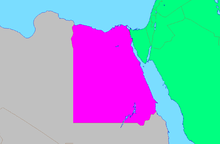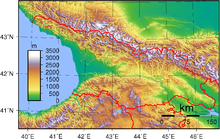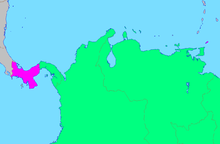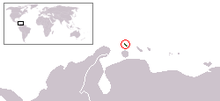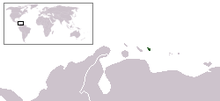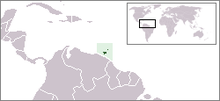- List of transcontinental countries
-
This is a list of countries spanning more than one continent, known as transcontinental states. While there are many countries with non-contiguous overseas territories fitting this definition, only a limited number of countries have territory spanning an overland continental boundary:
- Asian-European boundary: Azerbaijan, Georgia, Kazakhstan, Russia, Turkey;
- African-Asian boundary: Egypt; and
- under a less common, alternative view of the North-to-South American boundary, Panama.
Listed further below, separately, are countries with distant non-contiguous parts (overseas territories) on separate continents.
Contents
Contiguous boundary
Africa and Asia
- See Boundaries between continents for more details about the geographical border between Africa and Asia.
The land border between Asia and Africa is considered to go along the Isthmus of Suez and the Suez Canal in Egypt. The border continues through the Gulf of Suez, Red Sea and Gulf of Aden.
Egypt
Two of 29 governorates of Egypt lie entirely on the Asian Sinai Peninsula and two are transcontinental: Ismailia Governorate is nearly equally divided by the Suez Canal, and Suez Governorate, which is coterminous with the transcontinental city of Suez, has a small portion east of the Canal.
Asia and Europe
- See Borders of the continents for more details about the geographical border between Europe and Asia.
- See also Geographic criteria for EU membership.
- See also Transcontinental states with territory in Europe.
The modern definition of Europe (e.g. National Geographic Society) has the Europe-Asia boundary follow the watershed of the Ural Mountains to the source of the Ural River, then follows that river to the Caspian Sea. The border then follows the Greater Caucasus watershed from the Caspian Sea to the Black Sea. According to this mainstream definition, there are five states with territory across the continental boundary:
- Russia: with most of its population situated in Europe, has significant territory in Central and Northern Asia (Siberia in the Russian Far East. About 75% of Russian population lives in the European part.
- Turkey: mostly situated in Asia Minor, with some territory in Southeastern Europe (Turkish Thrace). About 88% of Turkish population lives in the Asian part.
- Kazakhstan: mostly situated in Central Asia, with the western parts of two of its provinces west of the Ural River in Europe. About 96% of Kazakh population lives in the Asian part.
- Azerbaijan: primarily situated in Transcaucasia, with five northeastern districts ("rayons") in European Ciscaucasia, north of the Greater Caucasus watershed. About 98% of Azerbaijani population lives in Transcaucasia.
- Georgia: primarily situated in Transcaucasia, with a small area just north of the Greater Caucasus watershed. More than 99% of Georgian population lives in Transcaucasia.
A convention in Russian geography draws the continental boundary along the Manych River to the Caspian, excluding Georgia and Azerbaijan from transcontinental status. A historical convention used in the 19th century followed the lower Volga instead of the Ural river, which would also exclude Kazakhstan from being transcontinental.
Azerbaijan
The northeastern Azerbaijan district borders run mostly along the main Caucasus watershed. Five districts are entirely within Europe, and the transcontinental Khizi district is almost equally divided on the two sides of the watershed. Azerbaijan is a member of the Council of Europe.
Georgia
The Terek and Sulak rivers both originate in Georgia and both empty into the Caspian Sea in Dagestan; their upper basins in Georgia are north of the Greater Caucasus watershed (the modern day Europe-Asia divide), including northern parts of the Tusheti and Khevsureti historical regions and Kazbegi District. A total of 2,650 square kilometers, or 4% of Georgia's territory, is north of the Caucasus Mountains and thus in Europe.
Kazakhstan
Kazakhstan's provincial borders do not follow the Ural River, although some of its western district borders do so. Two of the provinces are transcontinental, Atyrau Province and West Kazakhstan Province. The capital of the former, Atyrau, is split by the mouth of the Ural and is a transcontinental city. Almost all of it is in Asia with a small portion in Europe. Two of Atyrau Province's districts are entirely in Europe, three of its districts are entirely in Asia, and its Inderskiy and Makhambetskiy districts are transcontinental.[1] Five of West Kazakhstan's districts and the province's capital city of Oral are entirely in Europe, five of its districts are entirely in Asia, and its Akzhaikskiy district is transcontinental.[2]
Russia
Russian regions' borders follow the continental divide (Ural Mountains and Ural River) more often than not. There is also the relatively small 2600 square kilometer Sochi area of Russia in Asia, bordering Georgia and located south of the main Caucasus watershed. Orenburg on the Ural River is a transcontinental city. More detail on the political divisions through which the intercontinental boundary runs can be found here. Russia is a member of the Council of Europe.
Turkey
Main article: Turkish ThraceThree of Turkey's provinces are entirely in Europe while Çanakkale and Istanbul are transcontinental provinces. Three of Çanakkale's districts are entirely in Europe and its other nine districts are entirely in Asia. Nineteen of Istanbul's districts are entirely in Europe and its other twelve districts (forming Anatolia) are entirely in Asia.
North and South America
- See Borders of the continents for more details about the geographical border between the two Americas.
Panama
Most geographers consider Panama to be North America's southernmost nation, entirely within both Central America and North America.[3][4][5][6][7][8] A less common alternative view, that the man-made Panama Canal, the "concrete line" splitting the Isthmus of Panama, divides the continents[citation needed] would assign Darién Province to South America, Panamá Province and Colón Province to both, and the six other provinces to North America.
Non-contiguous
Asia and Europe
- See Borders of the continents for more details about the geographical border between Europe and Asia.
- The territory of Greece includes a number of islands just off the coast of Asia Minor, such as Rhodes, Samos, Chios and Lesbos.
Europe and North America
- Greenland: Greenland is today a territory of Denmark, fully located on the North American tectonic plate and close to the mainland, and is considered to be geographically part of North America. Although it is politically associated with Europe and internationally represented by a European country (including in the Council of Europe), it is largely autonomous. Historically and ethnically, its native population is of American tradition, although it also shares cultural links with other native peoples bordering the Arctic Sea in Northern Europe and Asia (today in Norway, Sweden, Finland and Russia), as well as in North America (Alaska in the U.S., Northwest Territories and Nunavut in Canada). Greenland was part of the Danish territory and within the territory of the European Union, but voted for a larger autonomy and is now excluded from it.
- Iceland: Iceland is located on the fracture line splitting the Northern Atlantic Ocean between the North American plate and the Eurasian plate. Geographically, it is much closer to North America than it is to Europe. Under a pure geological definition, Iceland would qualify as a transcontinental country ; however, ethnically, historically, and culturally, this country, well defined by the borders of its main island which was never split in separate cultural areas, is commonly considered to be European. Iceland is a full member of the Council of Europe (but still not in the European Union, to which it could qualify).
- Portugal: Continental Portugal is in Europe, while the Azores archipelago (also associated with Europe) has two islands (Corvo and Flores) that are part of the American plate (which made it a tricontinental country, see Africa and Europe section below).
Europe, North America, South America and Africa
- France: Metropolitan France is in Europe, while the five Overseas Departments are in other continents. Guadeloupe & Martinique are in North America, French Guiana is in South America, and Mayotte and Réunion are in Africa. These five French Overseas Departments are legally and administratively an integral part of France. There are other island possessions associated with North America, Africa, Oceania, and Antarctica that are French overseas collectives or part of the French Southern and Antarctic Lands, but these are not integral parts of France.
Africa and Europe
- See Borders of the continents for more details about the geographical border between Africa and Europe.
- Italy: Although mainland Italy, Sardinia, Sicily, the Aegadian Islands, Ustica, and the Aeolian Islands are associated with Europe, the closest land to Pantelleria and the Pelagie Islands (Lampedusa, Linosa and Lampione) is Tunisia on the African mainland. Nevertheless, Pantelleria and Linosa are considered part of Europe, Lampedusa and Lampione part of Africa.
- Malta: Malta has been geopolitically European in modern times, but may be considered geographically associated with Africa. More detail may be found here.
- Portugal: Continental Portugal is in Europe, while the archipelago of Madeira, an autonomous region of Portugal (including Porto Santo Island, the Desertas Islands and the Savage Islands), is associated with Africa. If we consider that the Azores autonomous region of Portugal have two islands that are part of North America (see Europe and North America section above), Portugal is a tricontinental country.
- Spain: Although its mainland is in Europe, Spain has holdings (the Canary Islands in the Atlantic, the cities of Ceuta and Melilla on mainland North Africa and its Plazas de soberanía close to those cities) that are geographically part of Africa. Canary Islands, Ceuta and Melilla are three of the 17 Autonomous Communities that form Spain, while the Plazas de Soberanía are under different military status. The African Mediterranean island of Isla de Alborán belongs to the transcontinental city of Almería and the transcontinental province of Almería.
Asia and Africa
- Yemen: Although mainland Yemen is in the southern Arabian Peninsula and thus part of Asia, and its Hanish Islands and Perim in the Red Sea are associated with Asia, Yemen controls the archipelago of Socotra, which lies east of the horn of Somalia and is much closer to Africa than Asia. Socotra and the Hadramawt region constitute the transcontinental Hadramawt Governorate.
Asia and Oceania
- Australia: The Commonwealth of Australia consists of its namesake continent and island possessions associated with Oceania, Asia, and Antarctica. Its Indian Ocean island possessions of Christmas Island and the Cocos (Keeling) Islands are associated with Asia. The majority of Australia's Asian island residents have Asian ancestry and are Muslim or Buddhist.
- Japan: All of Japan consists of Asian islands except for the remote Bonin Islands, which are a few islands located in the Pacific, and administratively part of the city of Tokyo and the subdivision of Ogasawara Village.[citation needed]
- Papua New Guinea: Anthropologically Papua New Guinea is a part of Melanesia and is sometimes included in the Malay Archipelago. It is an observer in ASEAN and has contemplated full membership.[9]
- Philippines, Malaysia, Indonesia, East Timor, Brunei and Singapore: The Malay Archipelago lies on the border of Oceania and Asia. Depending on the interpretation of the border, Philippines, Malaysia and Indonesia can be considered transcontinental countries and East Timor, Brunei and Singapore can be in either side.
North America, Oceania and Asia
- United States: While the territory of the United States lies overwhelmingly in North America, it includes the state of Hawaii in Oceania, as well as other Oceanian island possessions and Alaskan islands on NE Asia's continental shelf.
North and South America
- Aruba, Bonaire, Curaçao and Trinidad and Tobago: The sea islands division of South America and North America is complicated. All Caribbean islands are often labeled as North American, but the Dutch dependencies of Aruba and Curaçao, the Dutch special municipality of Bonaire and the state of Trinidad and Tobago lie on the continental shelf of South America,[citation needed] and can be considered South American as well.[citation needed] Note that all these islands have closer cultural ties with North America.
- Colombia: Mainland Colombia is in northwestern South America and Malpelo Island in the Pacific Ocean is also associated with South America, but the nation also controls the San Andrés and Providencia archipelago, 640 kilometres (400 mi) WNW of Colombia's Caribbean coast, near the Caribbean coast of Nicaragua. This archipelago is coterminous with the department of the same name.
- Venezuela: Mainland Venezuela is on South America, but Isla Aves are geographically North American. Isla Aves is one of the Federal dependencies of Venezuela under the administration of the transcontinental city of Caracas.
North American Caribbean islands belonging to South American countries:
South American Caribbean islands:
Other examples
- Chile is mostly on the South American mainland and includes the Oceanian islands of Easter Island and Sala y Gómez Island. They and the outlying South American Juan Fernández Islands and Desventuradas Islands are part of the Valparaíso Region.
- Denmark includes the North American island of Greenland and the Faroe Islands associated with Europe. Greenland was integrated into the Danish Kingdom in 1953 and home rule was granted in 1979. For more information see Rigsfællesskabet.
- The British Turks and Caicos Islands, consisting of two groups of tropical islands in the West Indies, the larger Caicos Islands and the smaller Turks Islands
- The Kingdom of the Netherlands includes the constituent countries of Aruba, Curaçao, and Sint Maarten. In addition, after the split of the Netherlands Antilles the Caribbean islands of Bonaire, Sint Eustatius and Saba became special municipalities incorporated into the metropolitan Netherlands.
These examples have integral parts associated with other continents. France, Norway, South Africa, and the United Kingdom may also be considered transcontinental by virtue of distant island possessions associated with a continent other than where the country is based.
Antarctica: claims
Main article: Territorial claims in AntarcticaA number of nations claim ownership over portions of the continent of Antarctica. Some, including Argentina and Chile, consider the Antarctic land they claim to be integral parts of their national territory. Some nations also have sub-Antarctic island possessions north of 60°S latitude and thus recognized by international law under the Antarctic Treaty System, which holds in abeyance land claims south of 60°S latitude.
See also
- Borders of the continents
- Dependent territory
- Historical powers
- List of countries by continent
- List of transcontinental empires and countries in history
- Thalassocracy
References
- ^ Brif.kz
- ^ Brif.kz
- ^ "National Geographic Education". National Geographic Society. http://education.nationalgeographic.com/education/mapping/outline-map/?map=Panama. Retrieved 2011-05-12.
- ^ National Geographic Atlas (list). National Geographic Society. 2010. p. 4.
- ^ Webster's New Geographical Dictionary (list and map). Meriam-Webster Inc.. 1984. pp. 856, 859.
- ^ "Americas" Standard Country and Area Codes Classifications (M49), United Nations Statistics Division
- ^ "North America" Atlas of Canada
- ^ North America Atlas National Geographic
- ^ Papua New Guinea asks RP support for Asean membership bid Retrieved July 8, 2009
External links
Categories:- Bicontinental countries
Wikimedia Foundation. 2010.

